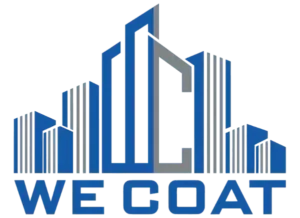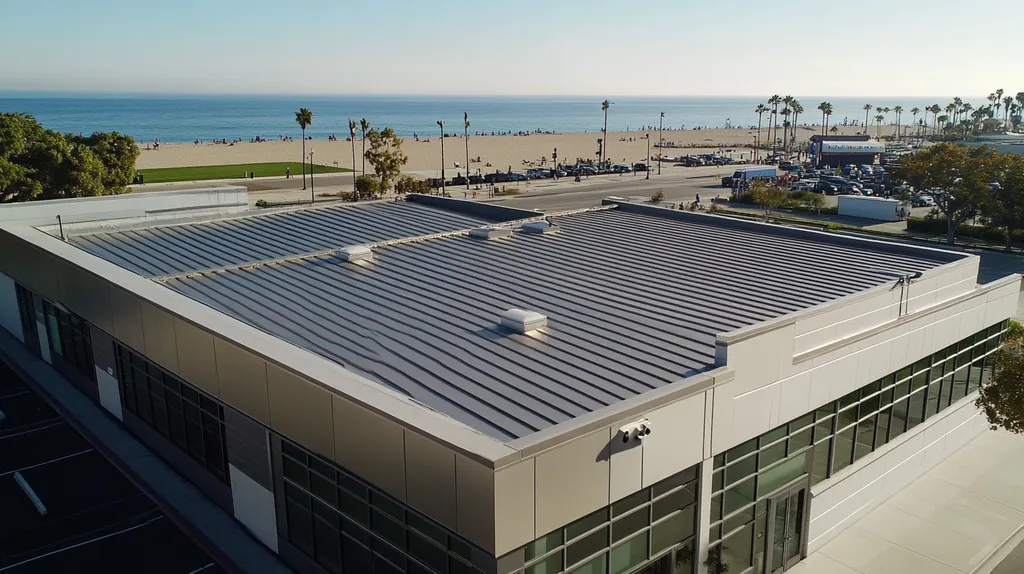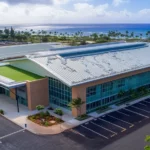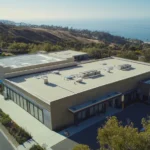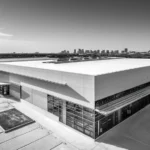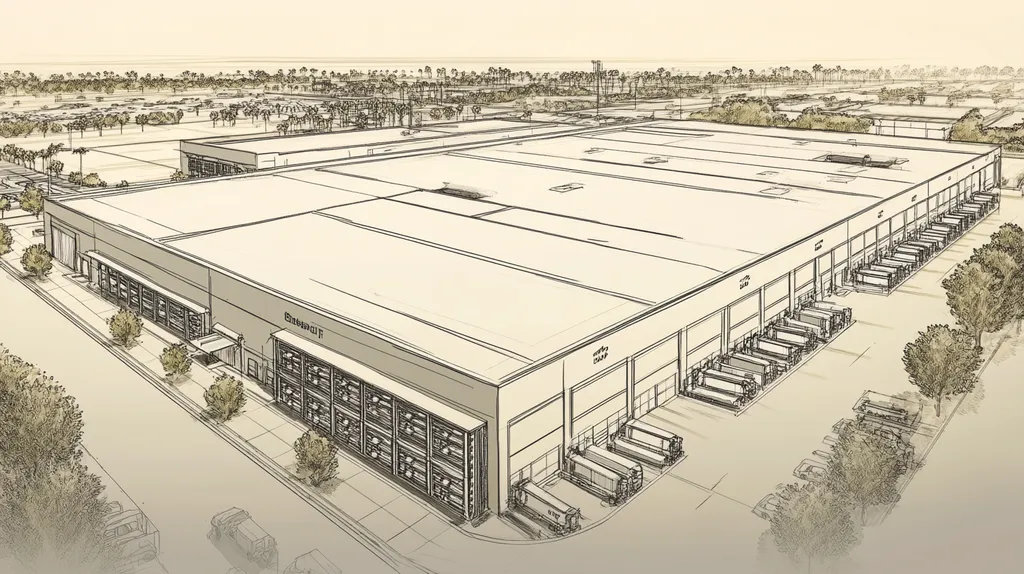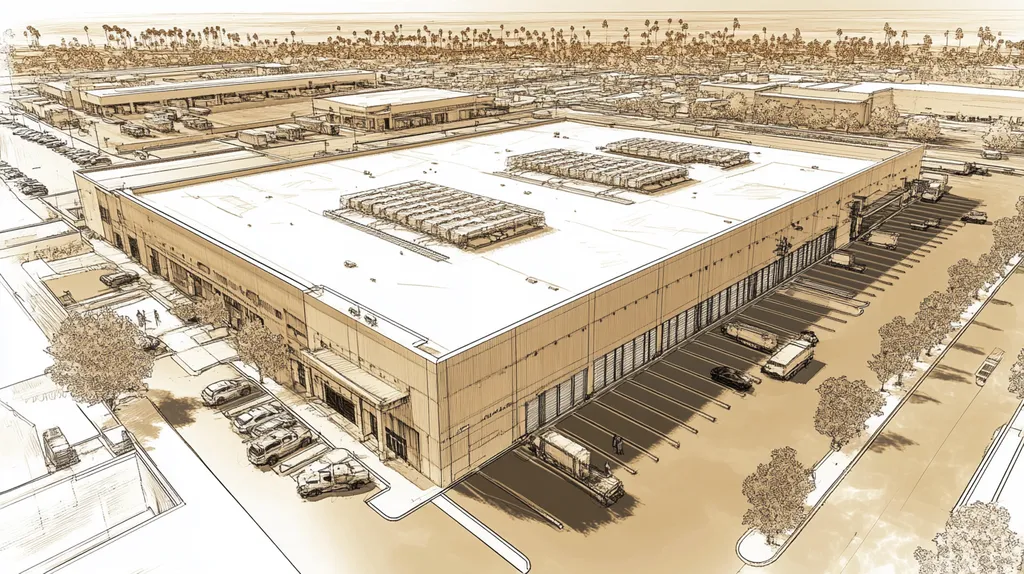Industrial roof coating failure costs facility managers millions each year in repairs and energy losses, with studies showing that 40% of commercial roofs require premature replacement due to inadequate maintenance.
Understanding common degradation patterns is crucial for protecting these vital assets and avoiding catastrophic failures that can shut down operations.
This comprehensive guide examines the key factors that cause coating breakdown, from UV exposure to poor drainage, while providing actionable solutions for maintaining coating integrity and maximizing service life.
SECTION 1: PERFORMANCE FACTORS
For facility managers, grasping the performance factors influencing industrial roof coatings is essential. Overlooking these critical elements can lead to rapid degradation and skyrocketing repair costs. A neglected roof can suffer serious deterioration in just a few years, underscoring the need for proactive maintenance. By taking the right actions, managers can significantly extend a roof’s lifespan and protect facility operations.
UV and Water Exposure Impact
Ultraviolet (UV) radiation and water exposure are major culprits in shortening the lifespan of industrial roof coatings. When roofs are continuously bombarded by UV rays, coatings can become brittle and lose their protective qualities. This degradation often shows up as cracking and peeling, seriously jeopardizing roof integrity and opening the door for leaks.
Pooled water is particularly detrimental, speeding up the deterioration process and causing blistering that further harms the coating, ultimately exposing the underlying structure. For example, a roof with standing water often incurs the need for more frequent re-coating or can even necessitate a complete replacement much sooner than planned.
To combat these risks, facility managers should conduct regular inspections and make timely repairs. Additionally, applying reflective coatings can lower heat absorption, helping to reduce thermal stress on the roof.
Key Action Items
Coating Material Deterioration
The choice of coating material has a direct impact on its durability and ability to resist degradation. Materials like silicone, acrylic, and polyurea come with distinct benefits that influence long-term performance. For example, while silicone coatings excel at repelling water, they may not hold up against prolonged UV exposure.
As coatings age, temperature fluctuations can cause them to expand and contract, resulting in cracks. Environmental contaminants such as dirt and chemical spills can also accelerate wear and tear on the coating material.
Regular maintenance, including cleaning and thorough inspections, is key to identifying and addressing deterioration early. Applying additional protective layers can further extend a coating’s lifespan against various wear factors.
Key Action Items
Surface Morphology Changes
The surface structure of the roof coating, known as surface morphology, is essential for its overall performance. As time goes by, environmental stressors can alter the consistency and texture of this coating. A roughened surface can increase friction but may also trap debris, which can lead to moisture issues.
These alterations often lower reflectivity, resulting in higher heat absorption and thermal stress on underlying materials. For instance, a smooth coating initially might be good at reflecting heat, but as it wears down, its thermal management decreases significantly.
Moreover, changes in surface morphology can affect how well new layers and repairs adhere, which can encourage water leaks or weaken repair bonds. Monitoring surface morphology regularly can help catch early signs of degradation.
Key Action Items
SECTION 2: FINANCIAL CONSIDERATIONS
Facility managers must grasp the financial impact of industrial roof coatings to avoid unexpected costs and maximize energy savings. Ignoring regular maintenance can lead to steep repair bills and significant increases in energy consumption; a poorly maintained roof may raise energy costs by as much as 30%. This section delves into the costs associated with maintenance and repairs, the savings generated from energy efficiency, and how to budget effectively for coating replacements.
Maintenance and Repair Costs
Investing in regular maintenance is key to extending the lifespan of industrial roof coatings. When small issues—like cracks— are neglected, they can lead to moisture infiltration, resulting in costly leaks and extensive damage. Proactive inspections help facility managers catch minor problems before they escalate.
Typically, annual maintenance costs about 1% of the roof’s total replacement value. While this might seem like a small expense, neglecting it can lead to substantially higher repair costs later on. Hiring qualified contractors ensures these inspections are thorough, enabling early detection of potential issues.
In essence, committing to regular upkeep is a wise financial investment that safeguards the facility’s roofing asset.
Key Action Items
Energy Efficiency and Savings
Industrial roof coatings significantly influence a facility’s energy efficiency. A well-maintained reflective coating can save energy by bouncing sunlight away, which reduces cooling costs during hot months. In fact, reflective coatings may lower energy expenses by 20-30%.
Choosing energy-efficient coatings is an investment that often results in long-term savings greater than the initial costs. Additionally, the right choice can improve energy ratings, making the property more attractive to eco-conscious tenants and clients.
Implementing these coatings also supports broader corporate sustainability efforts. Reducing energy consumption is essential for organizations aiming to minimize their carbon footprint and achieve environmental goals.
Key Action Items
Coating Replacement Budgeting
Setting a budget for coating replacements is vital for maintaining financial health. Industrial roofs require significant investment, and without allocating funds, unexpected financial burdens may arise. The cost of replacing a coating can range from $2 to $6 per square foot, influenced by materials and labor.
When formulating a replacement budget, facility managers should account for various coatings’ lifespans. This forward-thinking strategy ensures funds are available when required, preventing budgetary strain from surprise repairs.
Recognizing the warning signs of coating degradation allows for effective scheduling of replacements. Conducting routine assessments enables better budgeting across multiple years, helping facilities manage cash flow effortlessly.
Key Action Items
SECTION 3: COMPLIANCE REQUIREMENTS
Staying compliant with regulatory standards for industrial roof coatings is crucial to avoid hefty fines and protect facility integrity. Non-compliance can lead to structural damage and safety risks, with a significant number of facility managers underestimating this issue, often facing serious financial consequences as a result.
Regulatory Standards for Roof Coatings
Regulatory standards are in place to ensure that roof coatings are safe and effective, making it essential for facility managers to stay updated on these regulations. They dictate everything from the types of materials that can be used to the methods applied for installation. Ignoring these rules can result in steep penalties and costly remediation efforts.
For instance, the Environmental Protection Agency (EPA) has specific guidelines regarding the use of volatile organic compounds (VOCs) in roofing materials. Non-compliance not only poses health risks but also jeopardizes the environment.
To remain compliant, regular inspections and proper documentation are key. This diligence helps ensure that all materials in use align with the set standards, significantly enhancing the lifespan of the roof coating.
Key Action Items
Building Code Adherence
Compliance with building codes is a fundamental aspect of ensuring that roofing systems are effectively designed and installed. These codes establish performance criteria that roof coatings must meet, with more stringent requirements in regions exposed to extreme weather.
For example, in hurricane-prone areas, roofing systems must comply with specific wind resistance codes to prevent costly damage during storms.
Non-compliance can lead to complications with insurance claims should damage occur, as well as expose facility managers to considerable financial risks. Continuous education regarding building codes empowers managers to make informed choices about roofing products.
Key Action Items
Environmental Compliance
Environmental compliance has become a pressing issue in the roofing industry as regulations aimed at protecting air quality and minimizing waste take center stage. Many roofing materials contain hazardous substances that, if mishandled, can pose environmental threats.
For instance, certain coatings emit harmful emissions during their application and curing phases, requiring strict adherence to local air quality regulations. Meeting these standards not only protects the environment but also safeguards the workers involved in the application process.
Additionally, being environmentally compliant can enhance a facility’s reputation, showcasing its commitment to sustainability in a market increasingly focused on corporate environmental responsibility.
Key Action Items
SECTION 4: RISK MANAGEMENT
Effective risk management in industrial roofing is essential for safeguarding assets and ensuring the safety of facilities. Failing to maintain roof coatings can lead to severe issues like leaks and structural damages. Studies reveal that approximately 30% of commercial roofs fail due to inadequate upkeep. Facility managers must identify potential failure points to manage risks proactively. This section covers how to spot vulnerabilities, reduce water damage risks, and prevent structural weaknesses.
Identifying Potential Failure Points
Spotting the weak spots in roof coatings is critical for proactive maintenance. Common signs of degradation, such as blistering, peeling, and cracking, frequently arise around seams and penetrations. Facility managers should perform regular inspections to catch these issues early.
During inspections, it’s vital to closely examine the edges and laps where coatings tend to thin out. These regions are particularly prone to moisture infiltration. Ignoring these weaknesses can result in catastrophic failures, leading to costly repairs or complete roof replacement.
Advanced tools like infrared imaging can help uncover hidden moisture beneath the surface. By using these technologies, facility managers can pinpoint issues before they manifest as visible damage. Early detection not only saves time but also minimizes long-term costs linked to neglected roof systems.
Key Action Items
Mitigating Water Damage Risks
Water damage poses a significant threat to industrial roofing. Even small leaks can result in mold growth, insulation damage, and compromised structural integrity. Proper drainage and correct roof coating installation can greatly mitigate these risks.
Facility managers should ensure that roof slopes adequately direct water runoff away from critical areas. Regular cleaning of gutters and downspouts is necessary to prevent clogs that may lead to pooling and leaks.
Installing moisture detection systems can provide real-time alerts for when water intrusion occurs, allowing for quick responses that prevent more extensive damage. Additionally, maintaining a consistent schedule of inspections and prompt repairs are key to protecting against water damage.
Key Action Items
Preventing Structural Compromises
Maintaining structural integrity is vital for industrial facilities, and a failing roof can put it at risk. Degraded coatings and unresolved wear can lead to weight-bearing issues, ultimately resulting in structural collapse. Proper maintenance of the roof coating system is essential to avert such scenarios.
Regular roof evaluations should focus on the underlying roof structure’s condition. Facility managers must check for signs of sagging or visible deterioration that suggest serious underlying problems.
In some cases, applying a new layer of coating may reinforce the existing roof. This cost-effective strategy can extend the roof’s life without complete replacement. Additionally, hiring qualified professionals for inspections and repairs ensures adherence to industry standards, preventing potential structural risks before they escalate.
Key Action Items
SECTION 5: OPERATIONAL PROCEDURES
Overlooking operational procedures for industrial roof coatings can lead to costly damages and even total roof failure. Neglect in this area can reduce a roof’s lifespan by up to 30%, resulting in extensive repairs that could have been avoided. By emphasizing regular inspections and targeted maintenance, facility managers can catch degradation early, ensuring roof durability and protecting their investments.
Regular Inspection Protocols
Regular inspections are essential for preserving the integrity of industrial roof coatings. These checks should be scheduled at least bi-annually, ideally during spring and fall, to identify seasonal wear and tear. Additionally, it’s critical to conduct inspections after severe weather events, as storms can worsen existing vulnerabilities.
During inspections, facility managers must look for visible signs of deterioration, such as cracking, peeling, or discoloration of the coating. Pay particular attention to seams and edges, where leaks are most likely to develop. Documenting findings during these assessments helps track degradation patterns, allowing for timely actions.
Proactive inspections enable property managers to make informed decisions about necessary repairs or reapplications. Waiting for visible damage can lead to far more extensive and costly repairs, so staying ahead of potential issues is key. Engaging trained roofing professionals can enhance inspection accuracy and provide valuable insights into the roof’s condition.
Key Action Items
Drainage System Maintenance
Proper drainage is crucial for extending the life of industrial roof coatings. Ineffective drainage can result in water pooling, accelerating coating degradation and increasing the likelihood of leaks. Therefore, regular checks of gutters, drains, and downspouts are essential to ensure they are unobstructed and functioning correctly.
Clogs can occur from debris, leaves, or ice buildup, particularly in colder climates. Timely removal of these obstructions is vital in preventing water damage and prolonging the roof’s lifespan. Seasonal maintenance and cleaning of drainage systems help avoid costly emergency repairs.
Facility managers should also ensure that roofs have adequate slopes that facilitate proper drainage. Areas that are flat or experience drainage issues may degrade more quickly, necessitating expert evaluations and potential repairs. Prioritizing drainage maintenance significantly reduces the risk of larger issues down the line.
Key Action Items
Coating Application and Reapplication
The application of high-quality roofing coatings is vital in protecting industrial roofs from moisture infiltration and UV degradation. Facility managers should ensure that trained and certified contractors handle this crucial task. Proper coating application not only extends the roof’s lifespan but also improves energy efficiency by reflecting sunlight.
Timely reapplications are necessary to maintain protective qualities, typically every five to ten years, depending on the coating type. Regular inspections will guide facility managers on when to reapply coatings based on observed wear. Investing in reflective coatings can lead to significant energy savings over time, enhancing sustainability.
Utilizing advanced coatings with improved durability can reduce the frequency of reapplications. Staying updated on new products and technologies is essential, as innovative solutions continue to emerge in the roofing industry, ensuring roofs remain effective and cost-efficient.
Key Action Items
SECTION 5: OPERATIONAL PROCEDURES
Neglecting operational procedures for industrial roof coatings can lead to significant financial losses and structural damage. In fact, improper maintenance can reduce a roof’s lifespan by as much as 30%. Regular inspections and maintenance are vital for detecting early signs of degradation, helping to avoid costly repairs or replacements. This section outlines essential operational protocols that facility managers should embrace for effective roof maintenance.
Regular Inspection Protocols
Regular inspections are the backbone of maintaining the integrity of industrial roof coatings. Facility managers should schedule these inspections bi-annually; ideally, in spring and fall to catch seasonal wear and tear. Follow-up inspections should occur after severe weather events, as storms can exacerbate existing vulnerabilities.
During these inspections, managers should look for signs of degradation, such as cracking, peeling, or discoloration of the coating. It’s essential to pay special attention to seams and edges, where leaks are most likely to occur. Documenting findings during inspections helps track degradation over time.
Proactive inspections empower facility managers to make informed decisions about necessary repairs or reapplications. Waiting until visible damage appears can lead to extensive and costly repairs. Engaging trained roofing professionals for inspections enhances accuracy and provides insights based on industry best practices.
Key Action Items
Drainage System Maintenance
Proper drainage is essential for extending the life of industrial roof coatings. Without effective drainage, water pooling can accelerate deterioration and lead to leaks. Facility managers should conduct regular checks of gutters, drains, and downspouts to ensure they remain clear and functional.
Clogs from debris, leaves, or ice—especially in colder climates—can pose serious risks. Promptly addressing these clogs is vital to preventing water damage and extending the roof’s lifespan. Seasonal maintenance and cleaning of these systems are essential to avoid costly emergency repairs.
Additionally, it’s crucial to ensure that the roof has an adequate slope for proper drainage. Areas that are flat or have drainage issues can degrade faster. Regular evaluations by experts can help recommend necessary adjustments or repairs.
Key Action Items
Coating Application and Reapplication
Coating application is critical in protecting industrial roofs from degradation. Proper installation of high-quality roofing coatings prevents moisture infiltration and reflects UV rays, significantly extending the roof’s lifespan. Facility managers should ensure that a trained and certified roofing contractor handles this essential task.
The timing of reapplications is equally vital. Depending on the type of coating, reapplication may be necessary every five to ten years. Monitoring the condition of the coating during inspections provides data to guide these timelines.
Investing in reflective coatings can enhance energy efficiency by reducing cooling costs, benefiting both sustainability and bottom-line savings. Documenting coating applications and their performance helps maintain a comprehensive view of overall roof condition.
Utilizing advanced coatings with better adhesion and durability can lead to longer intervals between reapplications. Staying informed about new products and technologies is recommended, as innovations continuously emerge in the roofing industry.
Key Action Items
The Bottom Line
With industrial roof coating failures costing facility managers millions annually in repairs and energy losses, understanding and addressing degradation patterns is no longer optional – it’s essential for business survival.
Studies show that proactive maintenance and early intervention can extend coating life by 50% while reducing energy costs by up to 30%.
From UV damage and water infiltration to surface deterioration and drainage issues, facility managers must implement comprehensive inspection and maintenance protocols to protect their roofing investments.
By following the actionable strategies outlined in this guide, property managers can significantly reduce unexpected repairs, maintain regulatory compliance, and maximize the return on their roofing investments through proper coating care.
The difference between a protected facility and a compromised one often comes down to understanding these critical degradation patterns – and taking decisive action before small issues become major failures.
FREQUENTLY ASKED QUESTIONS
Q. What performance factors affect my commercial roof coatings?
A. The longevity of industrial roof coatings is influenced by UV exposure and water exposure. These factors can make coatings brittle and prone to cracking. Regular inspections are essential to combat these risks and extend your roof’s lifespan.
Q. How do maintenance costs impact my commercial roof budget?
A. Proactive maintenance expenses are about 1% of a roof’s total replacement value annually. Ignoring small issues can lead to massive repair bills, underlining the importance of budgeting for regular inspections to prevent larger problems.
Q. What compliance requirements should I know for industrial roofs?
A. Regulatory standards ensure the safety and effectiveness of coatings. Facility managers must stay informed about local regulations, such as VOC guidelines, to avoid penalties and ensure environmental safety.
Q. How can I identify potential failure points in my roof coatings?
A. Look for signs such as blistering or cracking, especially around seams and edges. Regular inspections help detect these vulnerabilities early, preventing catastrophic failures that lead to costly repairs.
Q. Why is proper drainage important for my commercial roof?
A. Effective drainage prevents water pooling, which can accelerate roof degradation and cause leaks. Regularly checking and maintaining gutters, downspouts, and roof slopes are crucial for the longevity of coatings.
Q. How often should roof coating applications take place?
A. Reapplications are typically needed every five to ten years, depending on the coating type. Regular inspections will guide timing, ensuring that your roof remains protected and energy-efficient.
Q. What is the best way to choose coatings for my industrial roof?
A. Select coating materials based on environmental conditions and the specific needs of your roof. Always consider factors like UV exposure and water-resistance properties to ensure optimal performance.
